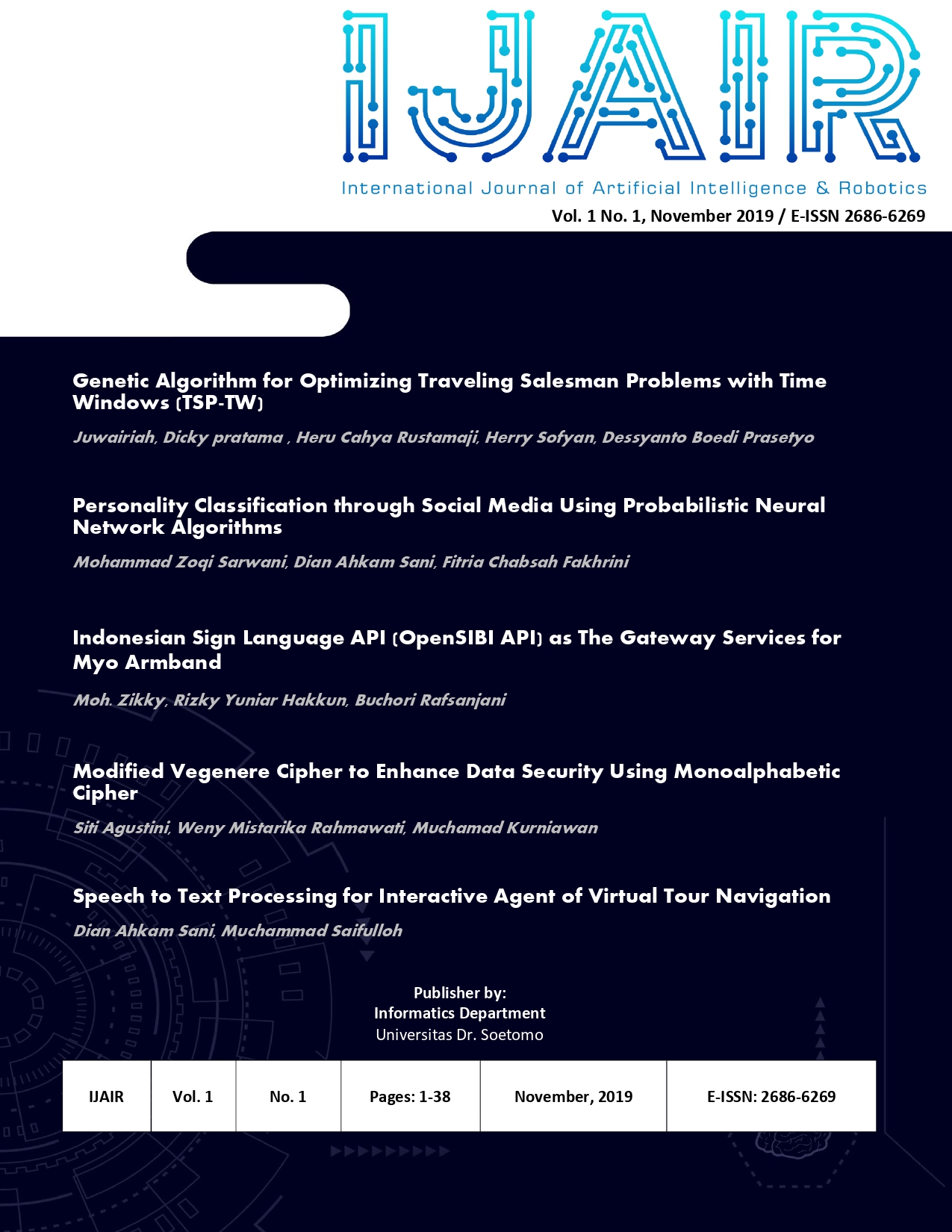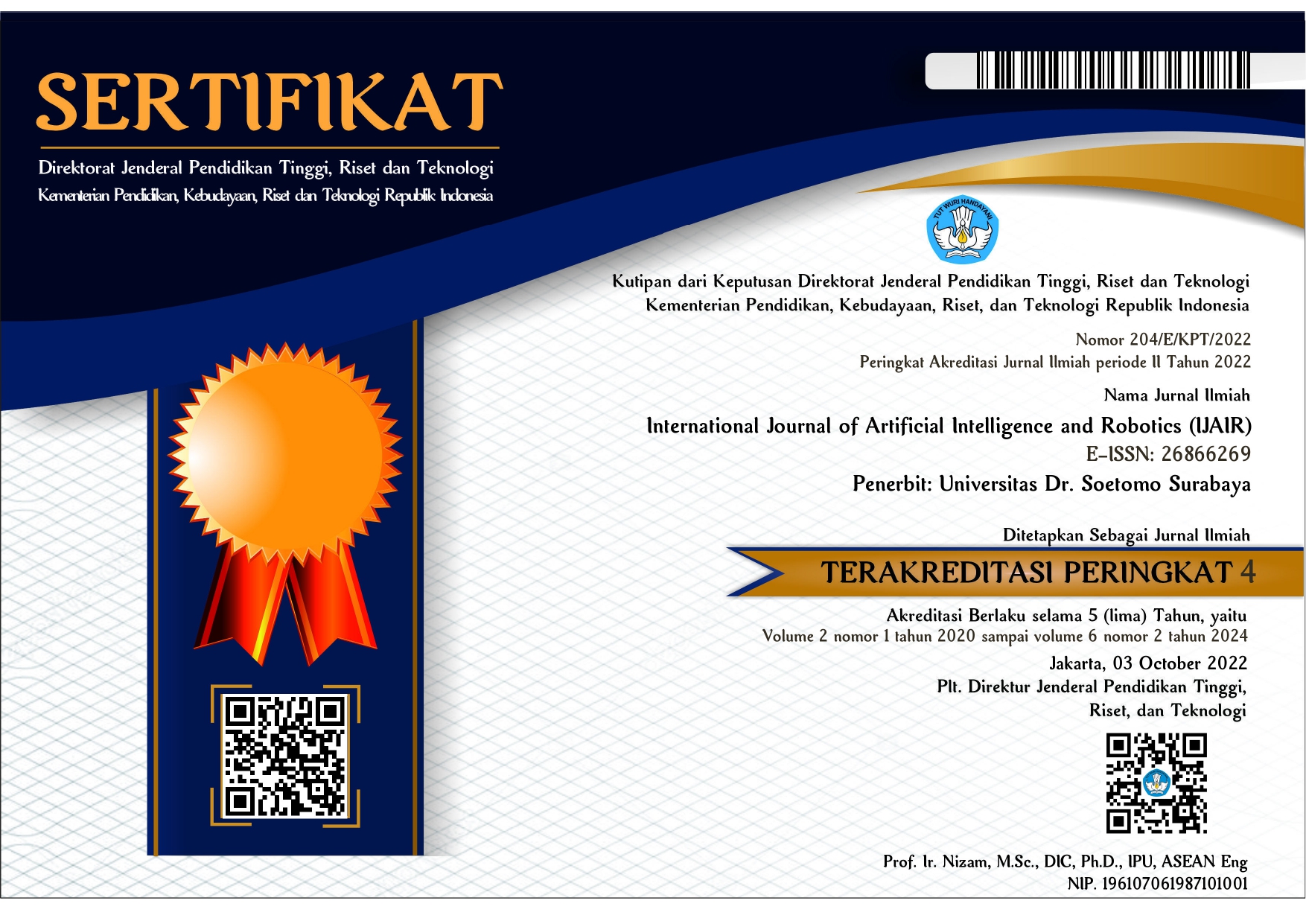Personality Classification through Social Media Using Probabilistic Neural Network Algorithms
 Abstract views: 566
,
Abstract views: 566
,
 PDF downloads: 407
PDF downloads: 407
Abstract
Today the internet creates a new generation with modern culture that uses digital media. Social media is one of the popular digital media. Facebook is one of the social media that is quite liked by young people. They are accustomed to conveying their thoughts and expression through social media. Text mining analysis can be used to classify one's personality through social media with the probabilistic neural network algorithm. The text can be taken from the status that is on Facebook. In this study, there are three stages, namely text processing, weighting, and probabilistic neural networks for determining classification. Text processing consists of several processes, namely: tokenization, stopword, and steaming. The results of the text processing in the form of text are given a weight value to each word by using the Term Inverse Document Frequent (TF / IDF) method. In the final stage, the Probabilistic Neural Network Algorithm is used to classify personalities. This study uses 25 respondents, with 10 data as training data, and 15 data as testing data. The results of this study reached an accuracy of 60%.
Downloads
References
[2] "Pengguna Internet di Indonesia 63 Juta Orang," 19 April 2019. [Online]. Available: http://kominfo.go.id/index. php/content/detail/3415/Kominfo+%3A+Pengguna+Internet+di+Indonesia+63+Juta+Orang/0/berita_satker.
[3] P. Q. Ayun, "Fenomena Remaja Menggunakan Media Sosial dalam Membentuk Identitas," Channel, pp. 1-16, 2015.
[4] A. T. Damanik and M. L. Khodra, "Prediksi Kepribadian Big 5 Pengguna Twitter dengan Support Vector Regression," Cybermatika, pp. vol. 3 - no. 1, 2015.
[5] E. Shofa, H. Yasin and R. Rahmawati, "Klasifikasi Data Berat Bayi Lahir Menggunakan Probabilistic Neural Network dan Regresi Logistik ( Studi Kasus di Rumah Sakit Islam Sultan Agung Semarang Tahun 2014 )," Jurnal Gaussian, pp. 815-824, 2015.
[6] M. Z. Sarwani and W. F. Mahmudy, "Analisis Twitter untuk mengetahui Karakter Seseorang Menggunakan Algoritma Naive Bayes Classifier," pp. 291-296, 2015.
[7] K. M. Lhaksamana, F. Nhita and D. Anggraini, "Klasifikasi Kepribadian Berdasarkan Status Facebook Menggunakan Metode BACKPROPAGATION," e-Proceeding of Engineering, p. 5174, 2017.
[8] M. Z. Sarwani and W. F. Mahmudy, "Campus Sentiment Analysis E-Complaint Using Probabilistic Neural Network Algorithm," Kursor, pp. 135 - 140, 2016.
[9] B. Heriwijayanti, D. E. Ratnawati and L. Muflikhah, "Klasifikasi Berita Online dengan Menggunakan Pembobotan TF-IDF dan Cosine Similarity," Pengembangan Teknologi Informasi dan Ilmu Komputer, pp. 306-312, 2018.
[10] A. Nilogiri, "Pengaruh Fitur Warna pada Klasifikasi Impresi Citra Batik Indonesia Menggunakan Probabilistic Neural Network," JUSTINDO, 2016.
[11] K. R. Prilianti and H. Wijaya, "Aplikasi Text Mining untuk Automasi Penentuan Tren Topik Skripsi dengan Metode K-Means Clustering," Cybermatika, 2014.
[12] E. K. Putri and T. Setiadi, "Penerapan Text Mining pada Sistem Klasifikasi Email Spam Menggunakan Naive Bayes," Jurnal Sarjana Teknik Informatika, 2014.
Copyright (c) 2019 Mohammad Zoqi Sarwani, Dian Ahkam Sani, Fitria Chabsah Fakhrini

This work is licensed under a Creative Commons Attribution-ShareAlike 4.0 International License.
Authors who publish with International Journal of Artificial Intelligence & Robotics (IJAIR) agree to the following terms:
-
Authors retain copyright and grant the journal right of first publication with the work simultaneously licensed under a Creative Commons Attribution License (CC BY-SA 4.0) that allows others to share the work with an acknowledgment of the work's authorship and initial publication in this journal.
-
Authors are able to enter into separate, additional contractual arrangements for the non-exclusive distribution of the journal's published version of the work (e.g., post it to an institutional repository or publish it in a book), with an acknowledgment of its initial publication in this journal.
-
Authors are permitted and encouraged to post their work online (e.g., in institutional repositories or on their website) prior to and during the submission process, as it can lead to productive exchanges, as well as earlier and greater citation of published work.















